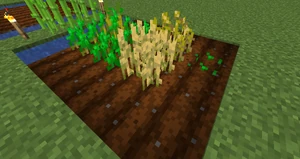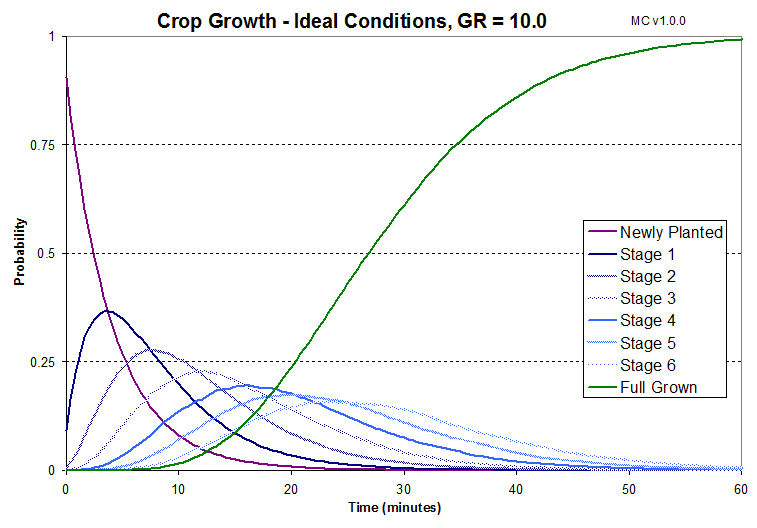- This page is about wheat farming. For information on the systematic production of other resources, see Renewable Resources. For information on growing melons, see Melon Farming. For information on growing pumpkins, see Pumpkin Farming.
Crops ready to be harvested
Wheat Farming is a feature in Indev, Infdev, Alpha and Beta implemented on February 6th, 2010. It allows players to plant wheat seeds on farmland, which then grow over time and can be harvested for wheat. Wheat Seeds can be found by destroying tall grass or by harvesting fully grown wheat.
Sowing
Wheat can only be planted on Farmland. Although seeds planted on hydrated farmland will grow faster than those on non-hydrated blocks, unhydrated farmland will still grow wheat eventually. Placing torches (Or any other light source, such as glowstone) near Wheat allows it to grow at night, with the additional benefit of preventing aggressive Mobs from spawning near them. However, if there is grass near the torches, passive mobs may spawn, which can destroy wheat by trampling it. To stop this from happening, well placed Fences can stop all mobs (except spiders) from reaching your farm. Alternatively, farming indoors can also isolate the crops from mobs.
Growth and Harvesting

In-game wheat, at several stages
Wheat crops will only grow under the following conditions:
- It is directly above a block of farmland. If the farmland is removed or reverts to dirt, the wheat crop will be broken.
- The light level above it is at least 9 (doesn't have to be sunlight)
- There is at least one block of empty space above it (transparent blocks count as empty)
- The player (any player in SMP) is within 7 chunks (about ~120 blocks)
Wheat does not need water to grow, however wheat crops can be destroyed if the farmland they are placed on reverts to dirt because it is not hydrated.
Wheat crops have a total of 8 growth stages. Each stage is a little taller and darker than the last. Growth happens at random intervals, but the average duration of each stage is between 5 minutes (in ideal conditions) to 35 minutes (in worst-case conditions).
Note: In earlier versions of the game, such as Indev, wheat ceased growing one stage earlier (0x6 in the above image).
Right-clicking on wheat crops with Bone Meal will advance them to the last stage instantly.
Crops can be harvested at any time by left-clicking with any tool, but they will only yield wheat when the crop has reached the final stage (when the grains have changed from green to brown). Harvesting at this time will yield 0-3 Seeds and one item of Wheat, which can be crafted into Bread, Cake, or Cookies. Harvesting at an earlier stage will yield only seeds, and the drop rate for these gets steadily lower for earlier stages.
Because harvesting one block at a time can become very tedious, some methods for automatically mass-harvesting wheat fields have been devised. See the Tips section below for details.
Growth Rate
Wheat growth is prompted by random update ticks (the same random events that, for example, create smoke particles above torches and play cave noises). For a given block a random update occurs an average of once every 82 seconds. However the delay can vary widely, and it is even possible (albeit very unlikely) for a crop to be updated multiple times in the same frame. During every update a wheat crop gets a chance to grow to the next stage.
Any farmland in the 9 blocks below the wheat add to its chances to grow. See the chart below for the approximate amount that each farmland block adds to the total probability.
If any wheat is growing in the eight surrounding blocks the growth probability is cut in half, unless the wheat is arranged in rows as shown below.
For the fastest growth, a solid layer of hydrated farmland with crops in rows is ideal. Under these conditions, the probability of growth during each update is approximately 30%, and most (75%) planted wheat will reach maturity within 35 minutes.
|
|
|
|
Replacing the unplanted farmland with other blocks reduces the growth probability to about 17%. This is also the approximate probability if wheat is planted outside of rows (but entirely on hydrated farmland). In either case, most planted wheat will reach maturity within about 58 minutes.
|
|
|
|
|
|
|
The absolute worst-case conditions for growing are two wheat crops placed diagonally on dry farmland. In this case the growth probability is approximately 4%, and it will take about 3 1/2 hours for most of the wheat to reach maturity.
|
|
The progression of wheat crops over time is shown in the plot below. Each line represents the probability if finding a given crop in that particular growth stage, assuming ideal conditions. The plots for non-ideal conditions look similar, with only the scale of the x axis (time passed) being longer.
Tips for Efficient/Automated Farming
Planting in rows on a layer of hydrated farmland produces the wheat the fastest for a given number of seeds. However, planting a solid area of hydrated farmland packs about twice as many individual crops into the same space, each taking about twice as long to mature (see the section on Growth Rates above). Thus, planting an area solid will produce roughly the same amount of wheat as planting it in rows, but will only need to be harvested half as often. This may suit some players who do not like to monitor their farms too closely.
Like redstone and other non-solid blocks, wheat crops are broken when water flows into them. If the water falls from above no items are dropped, but if the water flows in from the side wheat and seeds are dropped as if the crop had been harvested by hand. This can be used to harvest crops semi-automatically, and carry the resulting items to some central location. There are a number of examples of this method on Youtube. Note: water will not revert farmland back into dirt.
Wheat crops are also broken when pushed by pistons, with the same item drops as harvesting manually. The pistons will push the dropped items as well, potentially allowing them to be collected by an adjacent water current. However, using this technique will revert the farmland back into dirt, so that it needs to be re-tilled after every harvest.
Alternatively, sticky pistons can be used to move the farmland block itself, which will cause any wheat planted on it to break and drop items as normal. This will not revert the farmland to dirt. Water currents for collecting the items can be placed under the farmland rather than beside it, making this method more compact than harvesting directly with pistons.
While it is possible to automatically harvest wheat, there is currently no method to automatically replant it (although a number of popular mods do make this possible). Thus, even the most advanced wheat farms still require a reasonable amount of maintenance by the player.
Trivia
- Prior to the release of 1.0.0, if you placed fences under the hydrated dirt block, when you stepped on it they will not revert back to normal dirt. This did not work with nether fences.
References
See also
| Help | |||||||||||||||||||
|---|---|---|---|---|---|---|---|---|---|---|---|---|---|---|---|---|---|---|---|
| Menu screens |
| ||||||||||||||||||
| Game customization | |||||||||||||||||||
| Editions |
| ||||||||||||||||||
| Miscellaneous | |||||||||||||||||||




